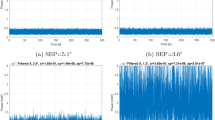Abstract
The 30 GHz signal which is received from the millimeter wave experiment on board the geostationary satellite ATS-6suffers from scintillation effects which are usually caused by refractive index fluctuations in the troposphere. The measurements show day and night differences with minima in the early morning and also differences depending on clear sky or cloudy sky. During rain the scintillations usually become smaller. Not only the copolar signal but also the crosspolar signal shows scintillation. In general, these fluctuations are larger than those of the copolar signal. A measuring set up will be shown for measuring the autocorrelation function of the scintillation signal. Knowing the autocorrelation function, the energy spectral density is known as both are a Fourier transform pair. The autocorrelation function is made visible on an oscilloscope and appears to be a function of time. By making a film the continuous changing picture of the auto correlation function is made visible.
Analyse
Le signal à 30 GHz reçu du satellite stationnaire expérimental ATS-6présente des scintillations qui sont produites en général par des fluctuations de l’indice de réfraction dans la troposphère. Les mesures montrent une différence entre le jour et la nuit avec un minimum au petit matin ainsi que des différences qui dépendent de la nébulosité. Pendant les pluies, les scintillations deviennent généralement plus faibles. La scintillation affecte aussi bien le signal en polarisation parallèle que celui en polarisation croisée qui présente souvent les fluctuations les plus importantes. L’auteur décrit un dispositif de mesure de la fonction d’autocorrélation du signal de scintillation. Connaissant la fonction d’autocorrélation, on en déduit la densité spectrale d’énergie, ces deux dernières formant une paire de transformées de Fourier. La fonction d’autocorrélation est observée sur un oscilloscope, ce qui permet de constater qu’elle varie en fonction du temps. A l’aide d’un film, on peut observer le changement continu de la fonction d’autocorrélation.
Similar content being viewed by others

References
Tatarski (V. I.). Wave propagation in a turbulent medium.McGraw-Hill, New York (1961), 285 p.
Lee (R. W.),Harp (J. C.). Weak scattering in random media, with applications to remote probing.Proc. I.E.E.E., U. S. A. (avr. 1969),57, n∘ 4, pp. 375–406.
Mandies (P. A.),Lee (R. W.),Waterman (A. T.). Spectra of short-term fluctuations of line of sight signals: electromagnetic and acoustic.Radio Sci., U. S. A. (mars 1973),8, n∘ 3, pp. 185–201.
Van Weert (M. J. M.). The influence of frequency and receiver aperture on the scintillation noise power. AGARD-Conf. Proc. 159, pp. 12–1 à 12–10, dans Electromagnetic noise interference compatibility.NATO-AGARD, Neuilly-sur-Seine, Fr. (nov. 1975), 586 p.
Martinon (R.). Needs for propagation research in view of the European Communication satellites programme. Proceedings Symposium Problems of space and terrestrical Microwave Propagation, 7–9 April 1975.Graz, Austria.
Fante (R. L.). Electromagnetic beam propagation in turbulent media.Proc. I.E.E.E., U. S. A. (déc. 1975),63, n∘ 12, pp. 1 669–1 692.
Rabler (G. M.). Scintillation effects at 4 and 6 GHz on a line of sight microwave link.I.E.E.E. Trans., AP, U.S.A. (juil. 1971),19, n∘ 4, pp. 574–575.
Dougherty (H. T.), Button (E. J.). Estimating attenuation, scintillation and scattering due to rainfall for satellite-ground systems.AGARD, Conf. on Propagation effects on frequency study. Rome, 7–11 mai 1973.
Thompson (M. C.),Wood (L. E.),Smith (D.) and (J.). Phase and amplitude scintillation in the 10–40 GHz band.I.E.E.E. Trans. AP, U. S. A. (nov. 1975),23, n∘ 6, pp. 792–797.
Thompson (M. C.), Wood (L. E.),Smith (D.) and (J.). Phase and amplitude scintillations at 9.6 GHz on an elevated path.I.E.E.E. Trans., AP, U. S. A. (nov. 1975),23, n∘ 6, pp. 850–854.
Wintroub (H. J.), Hoffman (L. A.). Space communication system consideration at 94 GHz.AGARD Conf. on Telecommunication aspects on frequencies between 10 and 100 GHz, Gausdal Norway, 18–21 sep. 1972.
Ippolito (L. J.). ATS-6. Millimeter wave propagation and communications experiments at 20 and 30 GHzI.E.E.E. Trans., AES, U. S. A. (nov. 1975),11, n∘ 6, pp. 1 067–1 082.
*** ATS-6 : millimeter wave propagation experiment data report.NASA contract, n∘ NAS 5.20904 (mai 1975), prepared byWestinghouse electric corporation.
Dijk (J.), Maanders (E. J.). Copolar and cross-polar signals received at 30 GHz from ats-6. Paper published in this issue.
Bendat (J. S.), Piersol (A. G.). Random data : analysis and measurement procedures.Wiley-Interscience, New York (1971), 407 p.
Author information
Authors and Affiliations
Rights and permissions
About this article
Cite this article
Dijk, J., Maanders, E.J. & de Winter, P.J. Scintillation effects receiving ATS-6 at 30 GHz. Ann. Télécommunic. 32, 508–513 (1977). https://doi.org/10.1007/BF03003504
Received:
Issue Date:
DOI: https://doi.org/10.1007/BF03003504



